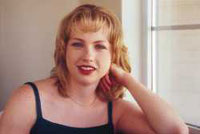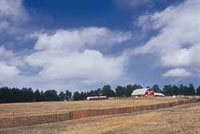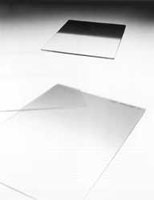Using Invisible Filters
Kicking Your Images Up A Notch
What would it be like to be invisible? --H.G. Wells' "The Invisible Man" Unlike the character from H.G. Wells' novel or James Whale's classic 1933 horror movie, you can actually see these filters. I use the term as a way to differentiate them from the filters used for black and white, special effects, or infrared photography. One of the biggest advantages of shooting with invisible filters is that your final image doesn't shout filter; instead they often look as if the photographs were made without using any kind of filter at all. This article takes a look at several types that I consider to be "invisible" along with a few suggestions on how to use them to improve your photographs, and have some fun at the same time. The invisible filters mentioned in this article are available from Adorama, B+W, Cokin, Heliopan, Hoya, Lee, Sunpak, Tiffen, and other manufacturers. While many camera companies also make them, the focus here is on filters that are designed to fit many different brands of 35mm cameras. |
|||||||||||||||||||||||||||||||||||||||||||||||||||||||||||||||||||||||||||||||||
They Almost Look Invisible. Of all the categories of filters--invisible or not--one of the more controversial and sure to start an argument among photographers, is the use of filters as lens protection. Many photographers use Skylight or UV (Ultra Violet) filters for that purpose and there's a class of filters, called "P" or "Clear" that offer nothing but protection for the front element of your lenses. To some photographic purists the idea of placing any kind of filter, even ones made from fine quality optical glass, in front of their lenses is offensive. In the not so distant past, I must confess to mounting a Skylight (my preferred protection filter) on every lens I owned. These days, I've mellowed a bit on this practice and only attach them when working under less hospitable situations, such as at the beach or in the desert. When shooting indoors or under other conditions, my Skylight filters come off. That's not to say that skylight and UV filters don't have their places. |
|||||||||||||||||||||||||||||||||||||||||||||||||||||||||||||||||||||||||||||||||
In addition to protecting the front element of your lens, a Skylight, also called "1-A", "Sky 1-A" or "KR," filter can absorb UV light and provide a slight warming effect for films that tend to represent colors on the cool side. It can absorb 46 percent of the UV light in a scene, while a dedicated UV filter will subtract 71 percent. Stronger UV filters, such as Tiffen's Haze 2A, absorb almost all UV light. For photographers who find themselves working in high altitude locations, such as the Rocky Mountains, a UV filter can be a big help with the high UV conditions they'll encounter. |
|||||||||||||||||||||||||||||||||||||||||||||||||||||||||||||||||||||||||||||||||
Polarizers. A polarizing filter eliminates reflections from non-metallic surfaces, increases color saturation, and can enhance an image's overall contrast. It's easy to abuse them by creating overpolarized post card like views or landscapes, but the judicious use of the polarizer can also add punch to your images. Many modular filters, such as those from Cokin and Lee, are made of optical plastic. When used with a polarizer, you should not position them between the polarizer and the subject. Instead, place them between the lens and polarizer. It used to be easy to purchase a polarizer: You went into a camera store, asked for one that matched your lens' filter thread size and you were ready to go. Nowadays, depending on your camera design, you may have to decide between a circular or linear polarizer. I used to think only autofocus cameras required one, but HP Marketing reminded me that Canon's FT was the first camera requiring a circular polarizer and it wasn't an autofocus model. |
|||||||||||||||||||||||||||||||||||||||||||||||||||||||||||||||||||||||||||||||||
The true qualifier for requiring a circular polarizer is whether or not your camera uses a semi-silvered mirror or beam splitter for metering or autofocus. When I switched to the Contax 35mm system, I wondered which one I would need for my cameras. Contax told me it depended on the camera model: when using the built-in spot metering capabilities, the Contax Aria, ST, RTS III, and 167MT models require a circular polarizer. In other metering modes, a linear polarizer works fine. The Contax AX and RX models, on the other hand, require a circular polarizer to operate properly with their focusing systems. As you can see, the kind of polarizer you need may not be as obvious as you might think. To find out, read your camera owner's manual or visit one of the web sites listed. If you cannot find out for certain it is always safe to use a circular polarizer since they will never interfere with any camera function. |
|||||||||||||||||||||||||||||||||||||||||||||||||||||||||||||||||||||||||||||||||
These days, there seems to be an indefinite number of spins that can be put on polarizers. Many manufacturers offer warm polarizers that combine a polarizer with a warming filter. Hoya offers a circular polarizer made from UV filtering glass to provide the effects of UV filtration and polarization at the same time, while Heliopan has a complete series including circular, linear and warm tone Käsemann polarizers with special edge sealing for working in extreme climates. Neutral Density. If there is one that could be called the Rodney Dangerfield of photography it's the Neutral Density (ND) filter. It lets you achieve control over an image when a combination of film speed, lens aperture, and shutter speeds won't let you produce the effect you want. For example, if you want to slow your shutter speed to produce smooth flowing water and your lens is already at its smallest aperture, an ND filter will let you drop down as much as three more shutter speeds. Conversely, if you would prefer to use a wider lens aperture to blur the background for a portrait, but have the camera set at its highest shutter speed and the aperture is still too small, an ND filter lets you open up a few stops. |
|||||||||||||||||||||||||||||||||||||||||||||||||||||||||||||||||||||||||||||||||
They are available in different
shades of gray and are typically rated by how many f/stops they decrease
your lens settings. For example a light gray ND filter produces a one-stop
decrease, a medium gray gives a two stop decrease, and a dark gray usually
provides a three stop decrease. Most companies make filters in these three
categories, but B+W and Hoya produce them in heavier densities for special,
industrial, or scientific applications. Heliopan even offers a double
polarizer that's really two filters sandwiched together that can
be rotated 90° to create stepless variable neutral density. Many are
available in thin mounts, making them easier to use on extreme wide angle
lenses. |
|||||||||||||||||||||||||||||||||||||||||||||||||||||||||||||||||||||||||||||||||
Graduated Neutral Density. These filters have a clear area at the bottom and somewhere around the middle, blending into an area of gradually darkening gray. They allow you to control areas of excessive brightness, such as a sky, bringing them into balance with the rest of a scene. The darker area covers less than half of the filter, but the effect can be adjusted vertically by moving square or rectangular modular filters up and down in their holders. Round graduated neutral density filters, such as Tiffen's Color Grad ND 6, rotate much like a polarizer. The effect on the photograph will vary based on the distance that the filter is placed in front of the lens, the position of a (modular) filter in its holder, the focal length of the lens, and the density of the filter used. The effect is more pronounced when a wide angle lens is used at small apertures, with an opposite effect produced at wider apertures with longer lenses. |
|||||||||||||||||||||||||||||||||||||||||||||||||||||||||||||||||||||||||||||||||
When looking through graduated neutral density filters, you can easily see the place where it changes from clear to neutral density. When it's attached to your camera it's not always so obvious where to position the filter in order to achieve the expected results. Here's what you should do: before inserting or screwing on the filter, take a light meter or manual reading of the foreground area. After attaching the filter, use your camera's depth of field preview control to stop the lens down to the shooting aperture. When looking through the lens you'll be able to clearly see where the density shift is on your image. This is also the time to experiment and move the filter up or down in order to position the gradation effect exactly where you want it. As you move the filter, the effect of the gradation will become readily apparent. Most graduated neutral density filters are available in different strengths. Singh-Ray's filters, which are compatible with Cokin's "P" holder, are available in two "soft-step" and two "hard-step" models. The soft-step models are designed for scenes with no distinct boundary between the light and dark areas. The hard-step models work best in scenes where sky and foreground are distinctly separated at the horizon. Both are offered in two or three-step density gradations. Cokin's two Grey Graduated filters pass the "duck test." They look, walk, and "quack" like graduated ND filters, but the company calls them "Grey." |
|||||||||||||||||||||||||||||||||||||||||||||||||||||||||||||||||||||||||||||||||
Let's Get Real Soft. Photographers love to purchase the sharpest lenses they can afford, but the first filter many of them use produces some form of diffusion to soften that image. Soft focus or diffusion filters can be used to soften a landscape without suppressing detail or to hide minor flaws on a portrait subject's skin. Diffusion filters come in an amazing variety, starting with "soft focus" up to "fog." The classic Zeiss Softar is available in three strengths, with one being the least soft and three being the softest. When looking at portraits made with a Softar I, the effect is not readily apparent until you compare it with an unfiltered image, which is when the true value of this invisible filter will be immediately apparent. These expensive filters are available in various sizes from Heliopan and Contax as well as in medium format bayonet sizes from Hasselblad and Rollei. |
|||||||||||||||||||||||||||||||||||||||||||||||||||||||||||||||||||||||||||||||||
One of my favorite group of soft focus filters is Tiffen's Hollywood/FX series. It includes a diverse group of products call Pro-Mist that are available in variations such as Warm Black, Black, and Warm Soft. As I was finishing this article, Tiffen introduced two new diffusion filters for movie and TV use. The Black Diffusion/FX filter adds a smooth look to textured surfaces, such as facial imperfections, and the Gold Diffusion/FX filters create a softening effect while adding a golden tone to shadows. When comparing a Soft FX No. 5 to a BDFX, the Soft FX appears more "dreamlike," whereas the Black Diffusion/FX is simply softer. The GDFX keeps skin tones and neutral colors compared to the warmer effects produced by a Warm Soft FX filter. Under certain lighting conditions, BDFX filters produce more subtle softening than the, Soft FX and don't create halation, tending instead to tone down highlights. Currently, they are only available in 4x4 and Panavision sizes for movie and TV use, but the company is considering introducing the BDFX in selected screw-in sizes in a kit that would include No. 3 and No. 5 filters. If and when a BDFX kit is available, I'll let you know. |
|||||||||||||||||||||||||||||||||||||||||||||||||||||||||||||||||||||||||||||||||
The next big step past diffusion is "Fog." One of the more interesting takes on fog filters is Lee Filters' Mist set. It consists of a graduated Mist, Mist Stripe and Mist Centre Spot filters, any of which can be used individually or in combination to create varying densities of mist and fog. Lee filters measure 100x150mm and are designed to fit one of the company's filter holders or bellows lens shades. As with many kinds of "invisible" filters, you may have to switch your camera into manual focus mode to make sure you get the maximum sharpness from your soft image. Wrapping Up. No single article can cover all of the various technical elements about how filters work or even the best way to use them. I've tried to introduce you to what I feel is a special class of filters and included several reasons why they should be part of your basic photographic tool kit. While looking through a manufacturer's filter catalog you may discover that there are a few others that might fall into the "invisible" category but haven't been covered here. Even though they exhibit some subtle color, Enhancer filters might be one of the most notable examples. At this year's PMA show, many companies wanted to build on the popularity of the red Enhancer to carve out a niche for new kinds of filters, including green and blue Enhancer or Intensifiers. A look at these products will be saved for a future foray into the world of filters. Camera Filters On The Web Using filters may seem a long way from using a computer, but there's lots of good information about filters and their technology available on the World Wide Web. Here's a guide to locating web sites that can help you learn more about using filters--both invisible and visible. B+W filters:
www.schneideroptics.com/filters/filters.htm |
|||||||||||||||||||||||||||||||||||||||||||||||||||||||||||||||||||||||||||||||||
Manufacturers/Distributors Adorama, Inc. (Pro-Optic filters) HP Marketing Corp. (Heliopan
Filters) Kyocera Corporation Lee Filters Lindahl Specialties Minolta Corporation (Cokin
Filters) Omega/Satter Pro4 Imaging Inc. Sailwind Photo/Camera World Schneider Optics (B+W filters) Singh-Ray Filters THK Photo Products, Inc. (Hoya
filters) Tiffen Manufacturing Corp. ToCAD America, Inc. (Sunpak
filters) F.J. Westcott Co. |












































